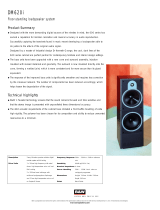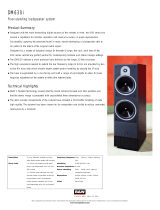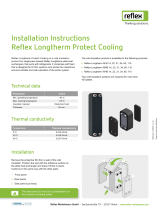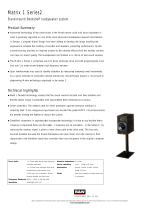Page is loading ...

M ISSION M-SERIES

{}

»
M Series
M
ission’s M-series comprises two complete
ranges of loudspeakers designed exclusively
for the music enthusiast. The beauty and
purity of each performance is conveyed through a starkly
realistic, chillingly accurate and spectacularly powerful
presentation of emotion.
Although remarkable value for money, Mission M-series speakers
are constructed using state-of-the-art materials and advanced
acoustic design. Mission’s ‘Diadrive’ bass units and ‘Viotex’ fabric
dome treble units, used throughout the M-series, are capable of
exceptional performance and
integrate seamlessly for an
astonishingly realistic vocal and
mid-range performance.
M-SERIES
“state-of-the-art
materials and
advanced acoustic
design”

Please refer to symbol reference, pages 36-38
M
3i offers startling performance through
highly advanced drive units and an
innovative cabinet design. Suitable for
stereo and home cinema applications, every speaker in the
range is fully magnetically shielded.
Viotex fabric dome tweeters, used throughout the range, are
capable of remarkable detail and resolution. Voices are
natural and unstrained. Mission’s DiaDrive bass units provide
remarkable bass performance
and a harmonious natural mid-
range. A new crossover design
derived from the highly acclaimed
Elegante series has been applied
to the M3i series. In addition,
crossovers are now wired to the
drivers using Mission’s special high
purity oxygen free cables. The result is that all the speakers
in the M3i series, whether used in a stereo or home theatre
system, exhibit a lively and musical performance with
enhanced rhythm and timing.
M3i
“startling
performance
through highly
advanced driv
e
units”
Technologies
OCu

>>0
m30i m31i m32i m33i m34i m35i m3c1i m3c2i m3dsi m3as
Enclosure Type 2-way refl ex 2-way refl ex 2-way refl ex 2-way refl ex 2-way refl ex 3-way refl ex 2-way refl ex 2-way refl ex 2-way refl ex refl ex
Frequency Response ±3dB 68 Hz - 20 kHz 65 Hz - 20 kHz 52 Hz - 20 kHz 44 Hz - 20 kHz 44 Hz - 20 kHz 40 Hz - 20 kHz 75 Hz - 20 kHz 56Hz - 20kHz 75 Hz - 20 kHz 30Hz - 165 kHz
Sensitivity SPL/m @ 2.83V 86 dB 88 dB 90 dB 90 dB 92 dB 92 dB 89 dB 91 dB 89 dB -
Volume 3.4 litres 7 litres 12.4 litres 12.4 litres 35.7 litres 47.7 litres 5.2 litres 9.7 litres 4.5 litres 35 litres
Impedance 8 Ohms compatible 8 Ohms compatible 8 Ohms compatible 8 Ohms compatible 8 Ohms compatible 8 Ohms compatible 8 Ohms compatible 8 Ohms compatible 8 Ohms compatible
Recommended Amplifi er 15 - 75 W 25 - 75 W 25 - 100 W 25 - 100 W 25 - 150 W 25 - 150 W 25 - 150 W 25 - 125 W 25 - 100 W Integrated 150 Wamp
Dimensions (H x W x D): mm 220 x 145 x 190 255 x 170 x 280 320 x 200 x 325 850 x 200 x 325 950 x 200 x 330 1030 x 260 x 375 135 x 500 x 130 165 x 430 x 230 230 x 360 x110 410 x 280 x 500
Cabinet Finishes Graphite Black Graphite Black Graphite Black Graphite Black Graphite Black Graphite Black Graphite Black Graphite Black Graphite Black Graphite Black
Wood Effect Beech Beech Beech Beech Beech Beech Satin Silver Beech Beech
Cherry Cherry Cherry Cherry Cherry Cherry Cherry Cherry
Satin Silver Satin Silver Satin Silver Satin Silver Satin Silver Satin Silver Satin silver Satin Silver Satin silver
Package Quantity Pair Pair Pair Single Single Single Single Single Pair Single
Included Accessories Wall fi xing Wall fi xing
Optional Accessories Wall Bracket Stancette Stancette
mh3c mh3s mh3sys Cinema 30
Enclosure Type 2-way refl ex sealed bipole comprising comprising
Frequency Response ±3dB 80 Hz - 20 kHz 110 Hz - 20 kHz 1 x mh3 centre 4 x m30i
Sensitivity SPL/M @ 2.83V 88 dB 87 dB 2 x mh3 surround 1 x m3c1i
Volume 3.2 litres 2.3litres 1 x m3as
Impedance 8 Ohms compatible 8 Ohms compatible
Recommended Amplifi er 25 - 100W 25 - 100 W
Dimensions (H x W x D): mm 120 x 330 x 130 130 x 300 x 125
Cabinet Finishes Graphite Black Graphite Black Graphite Black Graphite Black
Wood Effect Beech Beech Beech Beech
Cherry Cherry Cherry Cherry
Satin Silver Satin Silver Satin Silver Satin Silver
Package Quantity Pair Pair 3 pcs set set
Included Accessories
Optional Accessories Wall fi xing Wall fi xing

F
or twenty five years Mission loudspeakers
have been renowned world-wide for their
combination of advanced technology and fine
craftsmanship. Mission’s M5i series reflects that pedigree
and commitment to excellence in every aspect of its build,
quality and performance. The best result is a new generation
of loudspeakers that combine gracious styling with beautifully
finished real wood veneers and entrancing sound quality.
Every speaker in the M5i series has been fi ne-tuned by our
engineers to meet the challenging demands of the modern
range of AV, DVD and music formats. Whether your interest is
in stereo music reproduction or multi-channel movie surround
sound, any combination of M5i series speakers will delight your
aural senses. Their special combination of wide bandwidth
and stunning dynamic range bring both music sources and
movie soundtracks to life, allowing you to wallow in the
passion, drama and excitement recorded on CD and DVD.
Unrestrained sound quality and fi ne furniture looks, these
loudspeakers will gratify the senses and are a natural choice for
conoisseurs of music and movies.
M5i
Please refer to symbol reference, pages 36-38
Technologies
OCu
HQ
DCC

m50i m51i m52i m53i m5ci m5dsi m5asi
Enclosure Type 2-way refl ex 2-way refl ex 2-way refl ex 2-way refl ex 2-way refl ex 2-way refl ex refl ex
Frequency Response ± 3dB 64 Hz - 20 kHz 58 Hz - 20 kHz 52 Hz - 20 kHz 44 Hz - 20 kHz 65 Hz - 20 kHz 68 Hz - 20 kHz 28 Hz - 110Hz
Sensitivity SPL/M @ 2.83V 86 dB 87 dB 88 dB 89 dB 87 dB 87 dB n/a
Volume 4.5 litres 10.3 litres 16 litres 30 litres 8.3 litres 4 litres 52 litres
Impedance 8 Ohms compatible 8 Ohms compatible 8 Ohms compatible 8 Ohms compatible 8 Ohms compatible 8 Ohms compatible 8 Ohms compatible
Recommended Amplifi er 25 - 100W 25 - 100W 25 - 100W 25 - 150W 25 - 100W 25 - 100W n/a
Dimensions(H x W x D): mm 220 x 140 x 225 315 x 205 x 345 893 x 205 x 345 973 x 205 x 360 165 x 480 x 265 266 x 335 x 120 580 x 350 x 520
Package Quantity Pair Pair Single Single Single Pair Single
Cabinet Finishes Black ash Black ash Black ash Black ash Black ash Black ash Black ash
Silver Silver Silver Silver Silver Silver Silver
Included Accessories Wall Bracket (Pr) Stance (Pr) Stance (Pr) Wall Fixing Remote Controller

M
6i offers the ultimate in high power
performance. Highly effi cient drive units
mean more output per Watt of input
power, ideally suited to the demands of modern music and
home cinema.
An innovative new cabinet construction is used (TFCT) to
construct a 38mm thick front baffl e, coupled to a curved
cabinet construction. This creates an inert structure with
excellent acoustic properties – lowering cabinet response and
reducing resonance.
The ‘Paramid’ bass driver has a 32mm voice coil mounted on
a high temperature former suspended in a massive, shielded,
magnet system. It has a fast, dynamic response – damped to
produce a smooth and natural mid-range performance – yet
capable of explosive bass delivery.
M6i
Please refer to symbol reference, pages 36-38
Technologies
OCu
HQ
DCC

»
m60i m62i m64i m66i m6ci m6dsi m6as
Enclosure Type 2-way refl ex 2-way refl ex 2-way refl ex 2-way refl ex 2-way refl ex 2-way refl ex sealed box
Frequency Response ± 3dB 60 Hz - 20 kHz 58 Hz - 20 kHz 52 Hz - 20 kHz 44 Hz - 20 kHz 65 Hz - 20 kHz 75 Hz - 20 kHz 28 Hz - 110Hz
Sensitivity SPL/m @ 2.83V 86 dB 87 dB 88 dB 89 dB 87 dB 89 dB 250mV for 200W
Volume 6.5 litres 10.3 litres 16 litres 30 litres 8.7 litres 4.5 litres 30 litres
Impedance 8 Ohms compatible 8 Ohms compatible 8 Ohms compatible 8 Ohms compatible 8 Ohms compatible 8 Ohms compatible -
Recommended Amplifi er 25 - 100W 25 - 100W 25 - 100W 25 - 150W 25 - 100W 25 - 100W Integrated 350W amp
Dimensions(H x W x D): mm 305 x 180 x 240 319 x 205 x 330 893 x 205 x 330 968 x 205 x 330 178 x 480 x 251 230 x 360 x 110 500 x 320 x 430
Package Quantity Pair Pair Single Single Single Pair Single
Cabinet Finishes Graphite Black Graphite Black Graphite Black Graphite Black Graphite Black Black Graphite Black
Wood Effect Beech Beech Beech Beech Beech Silver Beech
Cherry Cherry Cherry Cherry Cherry - Cherry
Satin Silver Satin Silver Satin Silver Satin Silver Satin Silver - Satin Silver
Included Accessories Wall Fixing Remote Controller
Optional Accessories Wall Bracket (Pr)
Stance (Pr) Stance (Pr)
mh6s mh6 mh6
Enclosure Type comprising 2-way refl ex sealed bi-pole
Frequency Response ± 3dB 1 x mh6 centre 80 Hz - 20kHz 110 Hz - 20 kHz
Sensitivity SPL/m @ 2.83V 2 x mh6 surround 88 dB 87dB
Volume - 3.2 litres 2.3 litres
Impedance - 8 Ohms compatible 8 Ohms compatible
Recommended Amplifi er - 25 - 100W 25 - 100W
Dimensions(H x W x D): mm - 130 x 330 x 130 130 x 330 x 130
Package Quantity 3 pcs Single Pair
Wood Effect Graphite Black Graphite Black Graphite Black
Beech Beech Beech
Cherry Cherry
Satin Silver Satin Silver
Included Accessories Wall Fixing

TFCT (Transverse folded cabinet technology)
For our loudspeakers we use two u-shaped sections bonded
into each other to form a box, creating a structure that is much
stronger and more rigid than alternative methods.
The U-coupled front and rear baffl e greatly reduces cabinet
vibration and hence colouration.
Paramid
Mission’s ‘Paramid’ driver is formed using a sandwich
structure. Aramid polymer fi bres with incredible tensile
strength are sandwiched between two stiffer pulp lay-
ers. This creates a cone which is very light and stiff, yet has
superb internal damping. The internal damping drasti-
cally reduces cone-induced distortion by absorbing the
transverse waves that travel through a cone following
an impulse.
Viotex
Viotex is an extremely fi ne weave material which is both
incredibly light and, when woven into a matrix and
impregnated, is also very strong. Capable of moving at
incredibly high speeds with minimal inertia, Viotex not only
improves the upper frequency response band limit and
improves the detail resolution, it is incredibly natural and relaxed
in performance.
IDG (Inverted Driver Geometry)
Mission has pioneered the use of inverted driver
geometry. By placing the treble unit below the bass or mid-
T ECHNOLOGY
range driver, the length of path is equalised so the waves
coincide at the listener’s head-height. This principle is known
as ‘time-alignment’.
Granitech cabinet construction
Formulated to provide the best combination of rigidity, damping
and acoustic isolation, ‘Granitech’ is a stone-like material with a
granulated structure that breaks up sound-wave energy and pro-
vides an ultra-quiet structure.
Audiophile grade crossover
Mission use advanced computer modelling to produce an
optimum response and minimum phase shift through each crosso-
ver point. This is then refi ned through critical listening tests and
panel evaluation to produce an ideal performance.
Our audiophile crossovers include components to reduce the ef-
fects of driver impedance peaks which would otherwise cause un-
wanted phase shifts through the crossover region.
Crossover components are chosen for their specifi c audio
qualities, mounted on custom designed PCBs for minimum
interaction and mounted using soft resin to dampen any
mechanical interference.
Viscous laminated treble unit
The viscous laminated high frequency dome treble unit of-
fers exceptionally smooth high-frequency performance with a
superior off-axis response. The ferro-fl uid cooled voice-coil
design is optimised to provide minimal compression at high
volume levels with an ultra-fast transient response.
Magnetically shielded
All our magnetically shielded loudspeakers are ideal for use in
close proximity to all television sets or wherever magnetic inter-
ference is an issue.
Direct Coupled Crossover
The objective of any internal loudspeaker design is to transmit as
much of the music as possible to the drivers with the fewest pos-
sible components in the way, degrading the signal. By mounting
the crossover section directly to the rear loudspeaker terminals,
the signal path is shortened and number of internal connections
reduced.
Kapton voice-coil former
Kapton is a polyimide fi lm with both excellent electrical insulation
and thermal dissipation properties. Both qualities are essential for
developing a loudspeaker that can play with minimal distortion at
louder volume settings.
Gold-plated connections
Gold has both exceptional electrical conductivity and is also rela-
tively malleable. When used for electrical connections, it creates
a larger contact area and a lower resistance – ideal for preserving
the optimum signal quality.
Bi-wire terminals
Bi-wire terminals are used to allow the bass and high frequency
sections of a loudspeaker to be wired independently. All bi-wirea-
ble loudspeakers are supplied with ‘bridging’ clips, so that a single
wire can be used if desired.
Although the maximum benefi t of bi-wiring is achieved through
using two sets of amplifi ers with different channels driv-
ing the bass and treble frequencies, there are still signifi cant
acoustic advantages to running two sets of cable (or a spe-
cialist bi-wire cable) from a single set of amplifi er outputs.
When bi-amping (using two stereo amplifi ers) with bi-wire
speakers, it is recommended for each amplifi er to be driving
a bass and treble unit of one speaker, rather than having one
amplifi er driving both treble units and the other both
bass units.
HQ
DCC

High grade OFC (Oxygen free copper)
Copper is an excellent electrical conductor; however, oxygen im-
purities within the crystalline structure can adversely affect that
conductivity. By refi ning the copper to a much higher grade of
purity, electrical conductivity can be improved and hence signal
quality.
Ferrofl uid cooling
Treble voice-coils are fi ne wires and tend to get very hot
when used for a long time, or at high volumes. This can cause
distortion and compression if the excess heat cannot
be removed. Ferrofl uids are used in treble drive units to sink
heat between the voice-coil and the magnet assembly. They
also passively damp the movement of the cone. They reside in
what would normally be the air gap around the voice-coil, held in
place by the speaker’s magnet.
Neodymium
Neodymium magnets (NdFeB) are one of a class known as
‘rare earth’ magnets. They are also sometimes known as ‘super
magnets’ because of their unbelievable strength and small size.
They are ideally suited to audiophile loudspeaker applications
because of their strength, low weight, small size and their thermal
stability.
Die-cast Chassis
Die-cast chassis are a huge improvement over plastic or even
pressed steel units. Because of the manufacturing technique
used, they can have a more complex three dimensional shape
hence are much stronger. Because of their higher strength, they
can be manufactured with an open frame design. This allows
air moving backward from the cone to flow and be absorbed
within the cabinet rather than being reflected back through
the cone. There is an obvious improvement to mid-range clarity
and timing.
OCu
»
0

www.mission.co.uk
IAG House, Sovereign Court, Ermine Business Park, Huntingdon, Cambridgeshire, PE29 6XU,
Tel 01480 447700 Fax 01480 431767
/





